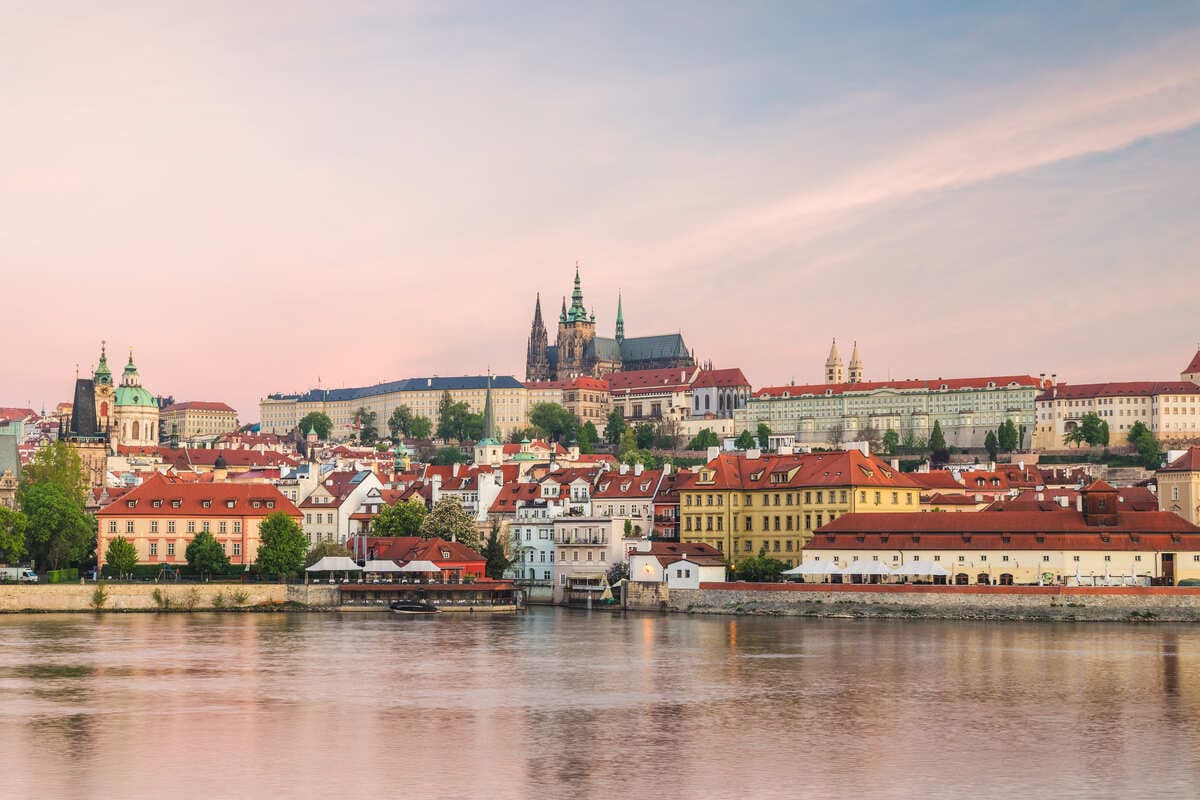[ad_1]
Last Updated
Forget Paris, Barcelona, London, and the like: if you’re a digital nomad on a European quest for a better quality of life, higher levels of safety, great connectivity––and even culture––your destination may lie further East than you might have suspected at first:

Eastern Europe is brimming with digital nomads, and if Nomad List‘s ranking of Best Places to live in the Old Continent is anything to go by, all your usual Western hotspots are losing momentum as once-overlooked destinations start catching up.
4 Eastern cities in particular seem to be experiencing the biggest surge in visiting nomads, and it’s time we had a look into the why:
Prague, Czechia

The capital of formerly-socialist Czechia, Prague has a monument-packed historic center encompassing an iconic square flanked by Gothic buildings, a 15th-century bridge, ornate Baroque churches, and a hilltop castle that’s among the largest in the world.
It’s called the City of a Hundred Spires, and good luck if you’re climbing up Petrin Hill in an attempt to count all of them (we never got further than maybe 30 ourselves).
Besides its obvious timeless beauty and cultural mightiness that would appeal to Europhiles, Prague is just as enticing a prospect for digital nomads: it’s one of the highest-ranking European cities on Nomad List currently, with near-perfect scores across the board.

Nomads love it for how safe it feels compared to much of Western Europe, where cities like Paris, Barcelona, and London have seen crime increase significantly, lively social scene––Prague’s cosmopolitanism is not to be underestimated––and a myriad of laptop-friendly cafes.
That being said, it’s not one of the cheapest nomad destinations East of the divide, nor the most welcoming:
Monthly expenses total $3,038 to live in (month-long stays on Airbnb cost $1,052 – $1,611, and consumer prices have increased), and based on Nomad List reviews, the perception of racial prejudice is higher among non-European residents, but the good far outweighs the bad.
Skopje, North Macedonia

Capital of a landlocked Balkan state that, much like Czechia, also had a socialist past, Skopje is a surprisingly laid-back city traversed by a scenic river, with your usual cobbled Old Town and castle on a hill––and countless celebratory kitsch statues.
Seriously, we doubt there’s another European city with a higher concentration of sculptures per square mile than Skopje: from Alexander the Great proudly mounting his horse to the pious Mother Teresa (who was born here), there are larger-than-life icons scattered all over the place.

Naturally, taking selfies with Skopje’s infamous rows upon rows of effigies is not the main reason why nomads are coming here: North Macedonia lies both outside the European Union and the eurozone, so needless to say, bureaucracy and prices here are much lower.
1 U.S. dollar equals 56.86 Macedonian denar, and considering the national minimum wage is a mere MKD 22,567, or around $400––as reported by Wage Indicator––you can guess how much further your hard-earned IT dollars will stretch in Skopje.

We’re talking $539 per month for an apartment rental in the city center, within walking distance of all the shops, cafes and main attractions, kebabs for around $6.18 in the Old Bazaar, or $30 for a more luxurious dinner for two in a mid-range restaurant.
Affordability and the absence of strict Schengen rules seem to be the two biggest draws here, as Nomad List respondents have reported ‘fun levels’ are just ‘okay’, and nightlife as being ‘bad’, but if you ever need somewhere cheap enough to lie low for a while, look no further than quirky Skopje.
Warsaw, Poland

One of the most innovative and fastest-growing business centers in the East, Warsaw is not your typical European city with postcardy streets exuding Old World allure and the fairytale castle on a hill, but it has something the others lack:
It’s as cosmopolitan as Europe gets after London, with towering skyscrapers as far as the eyes can see, manmade parks nestled amid the concrete jungle that will evoke your fondest memories of Manhattan, and a thriving social scene only a true global capital can offer.
The visiting nomad may wonder how exactly Warsaw turned out this way when many of its counterparts are, you know, more on the quaint side of things, but the truth is, much of the historical city was destroyed by bombing in World War II.

Boom. Gone. Literally razed to the ground and rebuilt anew from the 50s onwards.
That’s why, in strolling modernism-dominated Warsaw today, you get more ‘America’ vibes than you do ‘Europe’––except it’s kept the walkability, the living standards, and (at least some) of the centuries-old culture.
Old Town Warsaw, a reconstruction of the former medieval center, boasts a high concentration of cafes and pastry shops where nomads are more than welcome to sit and unwind for a while (you may even be able to spot the odd 14th-century structure that survived the bombing).

In Mokotów, however, it’s all about the shopping centers, including one of Warsaw’s busiest at Galeria Mokotów, and the riotous nightlife: Puławska Street is where you’ll find all of the trendiest cocktail bars and brewpubs in town.
Over in Bielany, a more laid-back, calm district on the banks of the scenic Vistula River, nomads get to enjoy peaceful riverside walks and abundant green spaces, and let’s not forget offbeat Powiśle, famous for the quirky art galleries and bistro scene.
As you might have guessed, despite its amazingness that would put it on a par with all of Western Europe’s grandest city breaks, life in Warsaw costs $2,812 per month, as reported by Nomad List, and the big plus is safety:

You’d maybe expect a city as big––1.7 million residents––to be awash with crime and other deep-seated urban problems, but that certainly doesn’t apply to Warsaw, where harm is unlikely to come to you walking alone at night as a woman, and violent crime is (mostly) unheard-of.
Murphy’s law once stated that anything that can go wrong will go wrong, but this doesn’t change the fact that safety levels in Warsaw are higher, and thus your risk of being affected by crime is subsequently lower.
Tbilisi, Georgia

The rising star of Eurasia, Georgia’s Tbilisi is an ancient queen famous for its eclectic architecture, comprising periods of Persian, medieval, Imperial Russian and socialist influence, picturesque Old Town, and most recently, for reinventing itself as a nomad hub:
At present, it’s the highest-charting city in Europe on Nomad List, and to the uninformed onlooker, this might seem a bit surprising considering Georgia’s relative anonymity, but we’re here to shed some light on it:
Unlike the namesake U.S. state, this country is not exactly associated with peaches, as much as it is with wine and centuries-old Orthodox churches.
As for Tbilisi itself, it’s proof that you can have one foot in Europe and another in Asia and get the best of both worlds.

It has a distinctly European feel about it, with wide boulevards lined by stately palatial complexes and ornate building facades, and your usual landmark squares and fairytale castle on a hill, but as nomads have been glad to report, price-wise it’s, well, on a par with Central Asia.
A modest meal in a cheap downtown restaurant will cost you $10, or the equivalent in Georgian lari, whereas a more elaborate dinner for two in a chic restaurant up the high-end Bambis Rigi will probably run you up a reasonable $44.20.
As for Airbnbs, monthly rentals in Tbilisi have definitely become pricier in the last couple of years owing to the influx of nomads––and Russians and Ukrainians fleeing the conflict in Eastern Europe––but there are still apartments for a surprisingly-affordable $665 – $745 per month on Airbnb.

Tbilisi’s unrivaled cafe scene is yet another compelling factor for remote workers. Places like Fabrika, Coffee LAB, and Lui Coffee cater to an international crowd and are well-equipped to host English-speaking guests.
Last but certainly not least, most nomads–and certainly Americans–can stay a whole year in Tbilisi visa-free, thanks to Georgia’s generous open-visa policy.
Learn more about it here.
↓ Elevate Your Travel↓
Sign Up Now For Travel Off Path Premium! No ads, VIP Content, Personal Travel Concierge, Huge Savings, Daily Deals, Members Forum & More!

✈️Join Our Travel Off Path Community Forum: Where travelers unite, ask questions, share experiences and even find like-minded travel buddies!
SUBSCRIBE TO OUR LATEST POSTS
Enter your email address to subscribe to Travel Off Path’s latest breaking travel news, straight to your inbox.
This article originally appeared on TravelOffPath.com
Opinions expressed here are the author’s alone, not those of any bank, credit card issuer, hotel, airline, or other entity. This content has not been reviewed, approved or otherwise endorsed by any of the entities included within the post.
[ad_2]
Source link

Leave a Reply